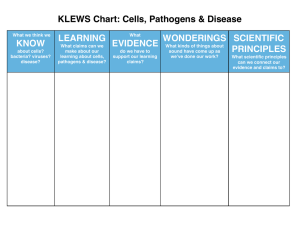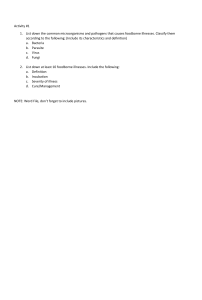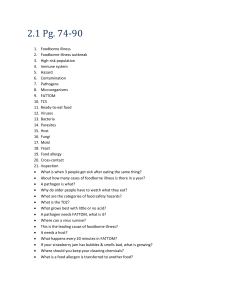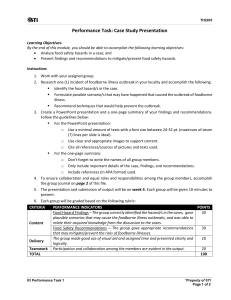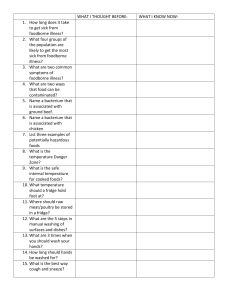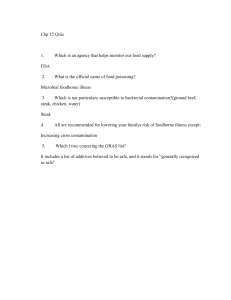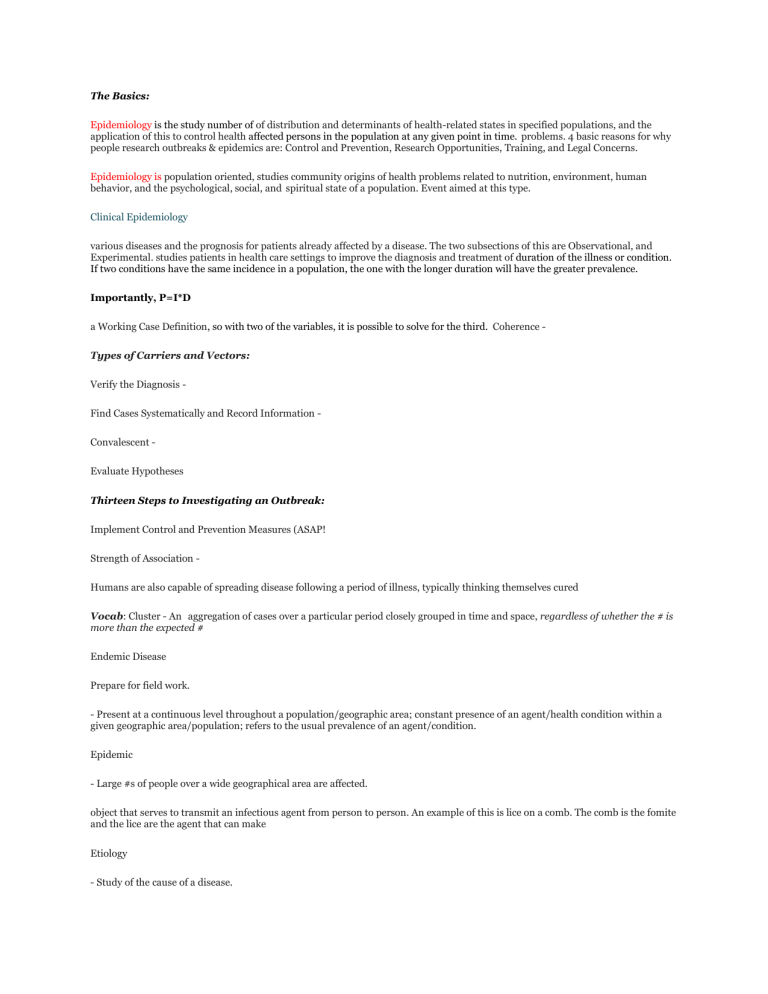
The Basics: Epidemiology is the study number of of distribution and determinants of health-related states in specified populations, and the application of this to control health affected persons in the population at any given point in time. problems. 4 basic reasons for why people research outbreaks & epidemics are: Control and Prevention, Research Opportunities, Training, and Legal Concerns. Epidemiology is population oriented, studies community origins of health problems related to nutrition, environment, human behavior, and the psychological, social, and spiritual state of a population. Event aimed at this type. Clinical Epidemiology various diseases and the prognosis for patients already affected by a disease. The two subsections of this are Observational, and Experimental. studies patients in health care settings to improve the diagnosis and treatment of duration of the illness or condition. If two conditions have the same incidence in a population, the one with the longer duration will have the greater prevalence. Importantly, P=I*D a Working Case Definition, so with two of the variables, it is possible to solve for the third. Coherence Types of Carriers and Vectors: Verify the Diagnosis Find Cases Systematically and Record Information Convalescent Evaluate Hypotheses Thirteen Steps to Investigating an Outbreak: Implement Control and Prevention Measures (ASAP! Strength of Association Humans are also capable of spreading disease following a period of illness, typically thinking themselves cured Vocab: Cluster - An aggregation of cases over a particular period closely grouped in time and space, regardless of whether the # is more than the expected # Endemic Disease Prepare for field work. - Present at a continuous level throughout a population/geographic area; constant presence of an agent/health condition within a given geographic area/population; refers to the usual prevalence of an agent/condition. Epidemic - Large #s of people over a wide geographical area are affected. object that serves to transmit an infectious agent from person to person. An example of this is lice on a comb. The comb is the fomite and the lice are the agent that can make Etiology - Study of the cause of a disease. Fomite - A physical - your hair itch. Iatrogenic - An illness that is caused by medication or a physician . Incubation Period - Time in between when a person comes into contact with a pathogen and when they first show symptoms or signs of disease. Index Case - First patient in an epidemiological study (also known as patient zero or primary case). Morbidity - Rate of disease in a population. Mortality - Rate of death in a population. Outbreak - More cases of a particular disease than expected in a given area or among a specialized group of people over a particular period of time. Pandemic - An epidemic occurring over several countries or continents and affecting a large proportion of the population. Plague - A serious, potentially life-threatening infectious disease that is usually transmitted to humans by the bites of rodent fleas. It was one of the scourges of our early history. There are three major forms of the disease: bubonic, septicemic, and pneumonic. Nosocomial Disease - An infection that is acquired in a hospital. Risk - The probability that an individual will be affected by, or die from, an illness or injury within a stated time or age span. Risk of illness is generally considered to be the same as the Incidence (see below) and the terms are used interchangeably. Risk of death from a particular illness is expressed as the Case Fatality Rate (# deaths due to a disease/# with the disease) or the Cause-specific Mortality Rate (# deaths due to a disease/# in population). Age span is a more common consideration in this last usage. Surveillance - The systematic and ongoing collection, analysis, interpretation, and dissemination of health data. The purpose of public health surveillance is to gain knowledge of the patterns of disease, injury, and other health problems in a community so that we can work towards their prevention and control. Vector - An animal that transmits disease but is not the cause of the disease itself. For example, a mosquito is a vector for malaria. Zoonosis - An infectious disease that is transmissible from animals to humans. Symptomatic - Showing symptoms or signs of injury. Asymptomatic - Showing no signs or symptoms, although can be a carrier of disease. Incidence, Prevalence, Duration: The incidence of an is the number of new instances of disease in a population over a given time period. It is expressed as "X cases/Y population/ Z time." The prevalence of an illness Refine Hypotheses Initiate or Maintain Communicate Findings – Consistency is the It is expressed as "X cases/Y population" . There are two major ways in which prevalence is measured: period prevalence and point prevalence. Think of point prevalence while period prevalence tracks the prevalence over a certain duration. as a snapshot of the population and its rate of a certain disease at a point in time Note the only difference is that incidence (I) includes time while prevalence (P) does not. Time (D) reflects the Establish the Existence of an Outbreak 1. - Research and Supplies, Official Arrangements, Safety Protocols, and Contact Severity, Potential for Spread, Public Concern, and Availability of Resources Errors/Biases, for That Matter) Consider Verify Procedures and Eliminate Experimental Error (and Other Time: Tables, Epi Curves; Place: Geographical Extent of Disease & Spot Map; Identify Descriptive Epidemiology - Analytical Studies (MUST Have a Control Group) Construct Describe and Orient the Data in Terms of Person, Place, and Time Demographic Information or Exposures to Risk Factor (Agent/Host/Environment Triad) = Chain of Transmission and/or Environmental Studies - Monitor Implementation: Track New Cases, Check the Outbreak’s Spread Outside Targeted Area, Control and Change if Needed Reports, To Important People and Public. Hill’s 9 Criteria for Causation: 1. relationship is clear and risk estimate is high. observation of association must be repeatable in different populations at different times a single cause produces a specific effect consideration of multiple hypotheses before making conclusions about whether an association is causal or not cause/exposure must precede the effect/outcome 6. Dose-Response Relationship - an increasing amount of exposure increases the risk the association agrees with currently accepted understanding of biological and pathological processes 8. Experimental Evidence - the condition can be altered, either prevented or accelerated, by an appropriate experimental process the association should be compatible with existing theory and knowledge, including knowledge of past cases and epidemiological studies. 7. Develop Hypotheses if Necessary Surveillance 10. Compare and Reconcile with Laboratory Specificity Alternative Explanations – Temporality Biological Plausibility - of the disease. Incubatory - When an individual transmits pathogens immediately following infection but prior to developing symptoms. Chronic - Someone who can transmit a disease for a long period of time. Genetic - has inherited a disease trait but shows no symptoms. Epidemiological Triads: Transient/Temporary - Someone who can transmit an infectious disease for a short amount of time. Epidemiologists use two triads. time. The second is described in the next section. form of the Chain of Infection described. : This is another common triad, which is an altered below. It is a companion to the Epidemiological Triad. It also has three components: 1. An external agent 2. A vector or fomite that transmits the disease 3. A susceptible host for the disease. This is used to define the major points of a disease case. Chain of Transmission Triad The first is the foundation for descriptive epidemiology - person, place and Epidemiological Studies: Basic Studies 1. Ecological - comparisons of geographical locations 2. Cross Sectional - a survey, health questionnaire, "snapshot in time" 3. Case-Control - compare people with and without disease to find common exposures 4. Cohort - compare people with and without exposures to see what happens to each 5. Quasi Experiments - research similarities with traditional experimental design or RCT, but lack element of random assignment to treatment 6. Randomized Control TrialEpi-Curves: An epi-curve is a histogram Point source epidemics occur Classic . Continuous common source epidemics Propagated (progressive source) epidemics occur /control. human experiment: gold standard that shows the course of an outbreak by plotting the number of cases of a condition according to the time of onset. Epi-Curves fall into three classifications: when people are exposed to the same exposure over a limited, well defined period of time. The shape of the curve commonly rises rapidly and contains a definite peak, followed by a gradual decline occur when the exposure to the source is prolonged over an extended period of time and may occur over more than one incubation period. The down slope of the curve may be very sharp if the common source is removed or gradual if the outbreak is allowed to exhaust itself. when a case of disease serves later as a source of infection for subsequent cases and those subsequent cases, in turn, serve as sources for later cases. The shape of this curve usually contains a series of successively larger peaks, reflective of the increasing number of cases caused by person-to-person contact, until the pool of those susceptible is exhausted or control measures are implemented. The distance between these peaks may be a rough indication of the incubation period of the disease. As the outbreak progresses, the peaks flatten out (think of the variance around a mean over multiple generations). One more type of epi curve that may come up is that of an intermittent source epidemic, where people are intermittently exposed to a source. There are generally multiple peaks in this type of curve. An example of this may be spoiled food at a store giving people an infection, where there are intermittent cases based on when people are exposed to this source. Error and Bias: Random error is the result of fluctuations around a true value implies, it is random, so it is impossible to correct. However, random error can be reduced; some ways include increasing the sample size and making measurements more precise, either by using a more accurate measurement device or by taking more trials. While these techniques would decrease random error, they can also be expensive. Better measurement devices will cost more, and more trials and a larger sample size will mean more work because of the sample population. As the term Precision is a measure of random error that is inversely related increasing random error decreases precision. Systematic error is any error other than random error. equipment or experiment design. For example, systematic error can occur if the markings on your ruler are wider. This would make the numeric measurements less than It is usually consistent and repeatable and often occurs from flawed what they actually are, making all data collected inaccurate. However, trends observed may still be preserved (shifting a line vertically preserves a line, as it is a rigid motion). Selection bias occurs when selection of participants for a study is affected by an unknown variable that is associated with the exposure and outcome being measured. Information bias occurs when bias is introduced through an error in measurement or observation. An example of information bias is recall bias. When studied, some subjects may more easily recall specific habits related to a disease or condition than subjects not affected with the disease or condition. Confounding bias is bias resulting from mixing effects of several factors. Unlike selection and information bias, confounding bias deals with causation and not variations in study results. Chain of Infection: susceptible host. Characteristics of Agents: Infectivity capacity to cause infection in a susceptible host, capacity to cause disease in a host, - severity of disease that the agent causes to host. : 1. Identify, define, and measure the health problem of interest 2. Collect and compile data about the problem (and if possible, factors that influence it 3. Analyze and interpret these data 4. Provide these data and their interpretation to those responsible for controlling the health problem 5. Monitor and periodically evaluate the usefulness and quality of surveillance to improve it for future use (surveillance of a problem often does not include actions to control the problem) Alternate Five Step Process for Surveillance: (Use One Above if Unsure): 1. Data Collection - reports, electronic and vital records, registries, and surveys. 2. Data Analysis - ideally analyzed by location to find illness’s location so resources are sent there. 3. Data Interpretation - identifying person, place, time to find how and why health events happened. 4. Data Dissemination (Distribution) announcements, reports, articles and media → to important people and the public. 5. Link to Action - without action, no real purpose (this version includes taking action). Laboratories, Physicians, or others regularly report cases of disease or death to the local or state health department. Local or State health departments initiate the collection of information from laboratories, physicians, health care providers, or the general population. The ongoing, systematic collection, analysis, interpretation, and application of real-time for disease that allow detection before public health authorities might otherwise identify them. Direct and . Direct Transmission includes Direct Contact and Droplet Spread. Examples of direct contact include things like kissing, biting, and contact with soil containing infectious agents that penetrate the skin or enter wounds. Droplet spread is essentially an "in your face sneeze or cough". The idea is up close and immediate. Indirect Transmission includes Airborne, Vehicles and Vectors. Airborne transmission involves dust or droplet nuclei (the latter are essentially little (<5 micron) particles that remain suspended in the air. Time and distance are both greater than for droplet spread (distance >6-8 ft). Vehicles include things like food, water, or fomites. Vehicles may passively carry pathogens or may promote growth or toxin production. Vectors are arthropods (e.g. mosquitoes, flies, lice, ticks) that spread infectious agents. If the agent (as with malaria) within the vector, the vector is said to be a Biologic Vector. If the agent is simply (think of a fly landing on feces and then a bowl of potato salad) it is a Mechanical Vector. Generally vector-borne diseases are thought of only in the context of biologic vectors. Rabies from a dog bite would be direct contact, not a vector. Note that while terms like food-borne, waterborne and zoonotic are not really included in this system - they are still valid. Five Step Process for Surveillance Pathogenicity Agent leaves the reservoir through a portal of exit, and is conveyed by some mode of transmission (vector, fomite), and enters the appropriate portal of entry to infect a Virulence Types of Surveillance: Passive SurveillanceActive SurveillanceSyndromic SurveillanceModes of Disease Transmission: The 2 main categories are Indirect Transmission (not Contact) multiplies or undergoes a change in life stage carried from one place to another Disease Prevention: Primordial prevention - intervention at the very beginning to avoid the development of risk factors the population may be exposed to. Often deals with changing physical and social environments. Primary prevention - early intervention to avoid initial exposure to agents of disease preventing the process from starting. person. By breaking the chain of an infection’s transmission, vaccination can also protect people who haven’t been immunized. But to work, this protection requires that a Secondary prevention during the latent stage (when the disease has just begun), the process of screening and instituting treatment may prevent progression to symptomatic disease. Tertiary prevention - during the symptomatic stage (when the patient shows symptoms), intervention may arrest, slow, or reverse the progression of disease. Quaternary prevention - set of health activities to mitigate or avoid consequences of unnecessary/excessive intervention of the health system. Social credit that legitimizes medical intervention may be damaged if doctors don't prevent unnecessary medical activity and its consequences. I immunity: Active Immunity- occurs when the person is exposed to a live pathogen, develops the disease, and becomes immune as a result of the primary immune response. Passive Immunity- from the maternal into the fetal bloodstream. Herd Immunity- short-term immunization by the Wcertain antibodies are passed protecting a whole community from disease by immunizing a critical mass of iAore than just the vaccinated certain percentage of people in a community be vaccinated. growth of foodborne pathogens. A stand for Acidity F stands for Food acidified foods require that the food is to be brought to pH 4.5 or below. heating. While most guidelines state two hours, a few indicate four hours is still safe. Oxygen: M stands for Moisture Food Based Illnesses: T stands for Time FATTOM is a device to describe the six favorable conditions required for the There are sufficient nutrients that promote the growth of microorganisms. Protein-rich foods, such as meat, milk, eggs, and fish are the most susceptible. Foodborne pathogens require a slightly acidic pH level of 4.6-7.5, while they thrive in conditions with a pH of 6.6-7.5. The FDA regulations for acid/ Food should be removed from TDZ within two-four hours, either by cooling or Food-borne pathogens grow best in temperatures between 41 to 135 °F (5 to 57 °C), a range referred to as the temperature danger zone (TDZ). They thrive in temperatures that are between 70 to 104 °F (21 to 40 °C). O stands Second T stands for Temperature: Almost all foodborne pathogens are aerobic, or requiring oxygen to grow. Some pathogens, like Clostridium botulinum, the source of botulism, are anaerobic. Water is essential for the growth of foodborne pathogens, water activity (aw) is a measure of the water available for use and is measured on a scale of 0 to 1.0. Foodborne pathogens grow best in foods that have aw between 0.95 and 1.0. FDA regulations for canned foods require aw of 0.85 or below. Food Borne Illness Prevention: 1. Cook meat, poultry, and eggs thoroughly. 2. Don't cross-contaminate one food with another. 3. Chill and refrigerate leftovers promptly. 4. Clean and wash all produce. 5. Report suspected foodborne illnesses to the local health department.
